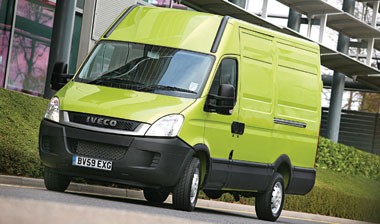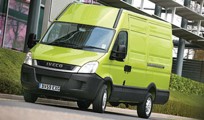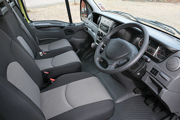Review
One of the unfortunate by-products of the recent recession is that some new van launches have been put back or even shelved.
We were, for example, due to see a new Vauxhall Movano and Renault Master (the same vehicle with different badges) in the autumn last year but these will now make their first showing in March.
Iveco has been having problems too and while the new Daily has been on sale in Europe since last year, we’ve had to wait until now for the UK launch.
But with green shoots tentatively poking their heads above ground after the harsh winter, the Italian maker has now revealed its new models in all their glory – and the huge range now includes both CNG-powered and electric-powered variants, alongside new 7.0-tonne versions that will carry as much cargo as three 3.5-tonners.
Iveco is proud of its efforts to promote greener motoring – after all, the huge outlay in production costs for the CNG and electric models is unlikely to be recouped by the small number of sales expected – but the firm believes that the Government too should make concessions so that more fleet buyers opt for these environmentally-friendly alternatives.
Nigel Emms, director brand and communications, said at the launch: “We need the Government to provide a lead. Products take huge amounts of time and money to develop.
“So what we need is a clear strategy, a preferred route, based on a five-year plan – an approach which encourages manufacturers and operators alike to make the investment necessary in this new technology.”
The Daily range has been around since 1978 and in that time has proved itself a solid and capable performer. As a panel van at 3.5-tonnes gvw, it is rather different from all the others inasmuch as it is a big truck with a proper chassis and rear-wheel drive that has been scaled down to size.
The problem, of course, is that only fleets with heavy-duty use are likely to be interested. You don’t see many florists using a Daily, for example.
For this new incarnation, Iveco is building on this reputation for chunkiness, so expect to see lots of tins of spinach featuring in future advertising.
In fact, all the Iveco staff at the launch in Coventry sported T-shirts heavily emblazoned with cans of Popeye’s favourite snack.
The new vehicle will be available as a panel van, window van, chassis-cab, chassis-crew cab and MPV.
The front has been restyled and now features a new grille with honeycombed centre and a much bigger Iveco badge.
Inside, the cab has been remodelled with a new dashboard featuring an aluminium finish centre console and there are new two-tone fabric seats.
Under the bonnet goes a new range of 2.3-litre and 3.0-litre diesel powerplants. The smaller unit offers 96bhp, 106bhp, 116bhp, 126bhp and 136bhp with torque from 177lb-ft to 236lb-ft while the larger one has 146bhp and 176bhp, with torque from 258lb-ft to 295lb-ft.
On the safety front, Iveco has added ESP stability control as a standard fitting, along with ABS brakes, ASR (anti-slip regulator) and hydraulic brake assist, which adds braking power in emergency situations.
Payloads and load volumes remain as with the old model.
Available as an option will be Fiat’s Blue & Me system which is voice activated for making phone calls on the move while a telematics function offers sat-nav and real-time information on fuel consumption, distance travelled, speed and engine usage.
CNG-powered versions of the Daily are now labelled EcoDaily and although the fuel isn’t available at present on Britain’s garage forecourts, Iveco works with potential fleet buyers to set up depot-based pumps that use biomethane provided by gasrec, a firm that extracts the gas from landfill rubbish sites (see Fleet Van, July/August 2009).
The CNG range is powered by a 3.0-litre diesel unit that rather curiously has a 14-litre petrol tank as a “get-me-home” emergency aid.
The electric Daily also gets the Eco moniker and as all the components are housed either in the engine compartment or the chassis side rails, there is no loss of loadspace.
Trials have shown the range to be 56-81 miles, while top speed is 44mph, which will limit this van’s appeal to round-town fleets. But as tailpipe emissions are zero, ultra-green fleets may well be interested. Prices range from £23,200-£44,050 (ex-VAT).
Behind the wheel
I’ve driven a good many Iveco Dailys in my time as a van journalist and I always enjoy the experience, not least because I always feel like a real trucker behind the wheel.
The Daily feels a much tougher cookie than most other panel vans and I was pleased to see that the overly large flat steering wheel has been retained, helping to give the van a big truck feel.
Ford, on the other hand, has given its Transit a dinky little wheel to help non-van drivers feel at home.
I always liked the massive hewn-from-concrete dashboards in the old Daily and, sadly in my book, that has been replaced by something more stylish and practical.
But the new model certainly looks smarter and in the cab there is a huge number of little nooks, crannies and cubby holes for all white van man’s detritus.
On the minus side, the door pockets only contain small drink bottle bins. Those big three-litre bottles that white van man loves simply won’t fit in.
The driver’s seat is solid and supportive but it lacks sideways support and, despite my relatively trim figure, I only just fitted on.
On the plus side, the two passengers seats are as comfortable as the driver’s seat, which is something you don’t always find with panel vans.
The steering wheel doesn’t adjust at all, as with the Ford Transit, but the seat can be cranked around in all directions so my co-pilot and I (who are both different sizes and statures) easily found comfortable positions.
The side mirrors are the biggest by far of any three-and-a-half tonner but on the nearside the A-pillar obscures the top portion.
Our test model was the 2.3-litre 106bhp version in medium wheelbase medium roof format, likely to be a major fleet seller.
The engine fired up quietly and smoothly and under way the Daily was much quieter than the old one, with pleasing all-round road manners.
However, the dash-mounted gearstick was a trifle rubbery on our model and my co-pilot and I agreed that an extra gear would have come in handy – ours only had five to choose from.
The test vehicle came three-quarters laden, which ironed out any possible skittishness, and it never felt as if it was really struggling.
Specification
Gross vehicle weight (kg): 3,500-7,000
Power (bhp/rpm): 96/3,900-170/3,500
Torque (lb-ft/rpm): 177/1,800-295/1,800
Load volume (cu m): 10.0-17.0
Payload (kg): 1,100-4,600
Comb fuel economy (mpg): 30.5-35.0
CO2 emissions (g/km): 0 (elec)-237
Prices (ex-VAT): £23,200-£44,050
Verdict
The tough guy of panel vans has shown it has a more refined side too. Top marks to Iveco for making ESP standard and for its commitment to the development of alternative fuels.


















